
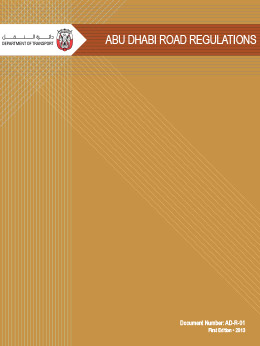 The Road Regulations (“Regulations”) were prepared for purposes of regulating all roads, which fall within the jurisdiction of the Department of Transport of the Emirate of Abu Dhabi (“DOT”). Abu Dhabi Law No. (4) Of 2006 as amended by Abu Dhabi Law No. (5) Of 2008 (“Laws”), specifically made the DOT responsible for the economic oversight and supervision of the transport sector in the Emirate of Abu Dhabi.
The Road Regulations (“Regulations”) were prepared for purposes of regulating all roads, which fall within the jurisdiction of the Department of Transport of the Emirate of Abu Dhabi (“DOT”). Abu Dhabi Law No. (4) Of 2006 as amended by Abu Dhabi Law No. (5) Of 2008 (“Laws”), specifically made the DOT responsible for the economic oversight and supervision of the transport sector in the Emirate of Abu Dhabi.
The Regulations were not drafted in a vacuum. The DOT had an ongoing exercise where various manuals related to road management and operations were being simultaneously drafted. As such, various matters are addressed in these road manuals and needed not be included in the Regulations.
The drafting process involved balancing the best practices against the local requirements and systems that were already in place in Abu Dhabi. The existing legislation in the UAE already provided a framework within which the Regulations were to be drafted. The first key issue that needed to be determined was the review and establishment of a clear understanding of the legal mandate of the DOT as per relevant legislation and its interaction with various other entities.
The Regulations are intended to be the rules governing use, management, control and exploitation of roads that are within the DOT’s mandate and have therefore been drafted, and are to be read in conjunction with the appropriate manuals.
The approach adopted in the development of the Regulations was based on the following main activities:
Based on the knowledge gained from the review of international best practices, federal and Abu Dhabi laws and continuous coordination with local consultants, a comparative analysis was done to evaluate the level of substantiation of the prevailing laws towards the best practices that are deemed to be appropriate for adoption by the DOT.
The development of the deliverables due was based on the following steps:
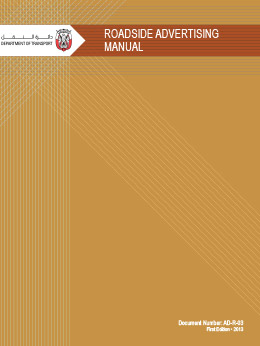 The Roadside Advertising Manual defines what constitutes roadside advertising and the role it plays for road users, as well as the DoT’s role and approach to its regulation. The Manual categorizes and provides a brief definition and illustration of seven distinct types of roadside advertising signs, lists the requirements for the DOT’s approval procedures and permits, provides detailed information on the general and specific criteria for the regulation of roadside advertising. The manual also covers compliance and enforcement issues, indemnity, insurance, removal and potential compensation for removal of unauthorized roadside advertising devices.
The Roadside Advertising Manual defines what constitutes roadside advertising and the role it plays for road users, as well as the DoT’s role and approach to its regulation. The Manual categorizes and provides a brief definition and illustration of seven distinct types of roadside advertising signs, lists the requirements for the DOT’s approval procedures and permits, provides detailed information on the general and specific criteria for the regulation of roadside advertising. The manual also covers compliance and enforcement issues, indemnity, insurance, removal and potential compensation for removal of unauthorized roadside advertising devices.
The scope of this manual encompasses guidelines and standards related to the use of all roadside advertising located within 300 meters of the nearest edge of the right of way visible from the main road, and erected with the purpose of the message being read from the main road.
The Roadside Advertising Manual is divided into eight chapters. The first chapter is the Introduction, which establishes the definition and role of roadside advertising, the DOT’s role and approach to roadside advertising regulation as well as the layout and scope of the manual. Chapter 2 categorizes and provides a brief definition and illustration of seven distinct types of roadside advertising signs. The subsequent chapter lists the requirements for the DOT’s approval procedures and permits. Chapter 4 provides detailed information on the general criteria for the regulation of roadside advertising and is divided into two major sections: Safety; and Visual Amenity. Chapter 5 provides explicit criteria for the regulation of roadside advertising, including size, spacing, lighting, and maintenance access. Chapter 6 covers compliance and enforcement issues and Chapter 7 covers miscellaneous issues that deal with indemnity, insurance, removal and potential compensation for removal of unauthorized roadside advertising devices. Chapter 8 contains a list of references used either directly or indirectly in the development of this manual.
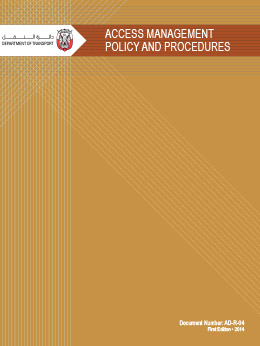 The Access Management Policy and Procedure (AMPP or Policy) was prepared to regulate all access to and from all roads open to the public within the Emirate of Abu Dhabi. The AMPP has a primary goal of protecting the public investment by ensuring the long term roadway functionality; improving the appearance of the roadway and roadside areas; improving air quality; supporting local, regional and Emirate land use policies, plans and programs; and protecting private investments by providing equitable and functional rules for owners of property adjacent to roadways. The emphasis of access management is on reducing the problems attributable to unmanaged vehicular access.
The Access Management Policy and Procedure (AMPP or Policy) was prepared to regulate all access to and from all roads open to the public within the Emirate of Abu Dhabi. The AMPP has a primary goal of protecting the public investment by ensuring the long term roadway functionality; improving the appearance of the roadway and roadside areas; improving air quality; supporting local, regional and Emirate land use policies, plans and programs; and protecting private investments by providing equitable and functional rules for owners of property adjacent to roadways. The emphasis of access management is on reducing the problems attributable to unmanaged vehicular access.
The AMPP establishes a hierarchical system of levels of access management that provides a balance between mobility and accessibility for each roadway type. It allows the access program to be context sensitive. It puts access management into the hands of transportation leadership to decide the level of access control that is consistent with the long-term function of the road and how that function supports the transportation vision and needs of the Emirate.
The AMPP was not prepared as an informational or instructional manual. It was prepared to regulate access and was therefore written in more directive language to set standards and procedures.
This regulatory document includes procedures to review and make decisions on the issuance of permits for access to the road system. It establishes design criteria for access related improvements to accommodate traffic in a safe and efficient manner. In addition to a system wide access classification system, the AMPP allows the creation of access management plans. These instruments establish corridor, interchange and network access plans for specific locations allowing a greater degree of flexibility when deemed necessary. In order to affect the implementation of the access classification system, it provides procedures for making access category assignments.
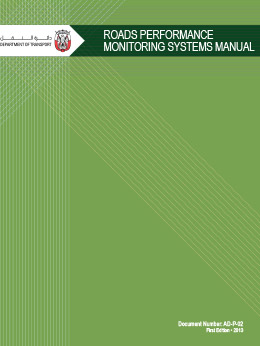 Most national departments of transport have collected systematic data on their roadway systems since the middle of the twentieth century. These processes are typically referred to as performance monitoring systems. This document examines these existing processes and leverages best practices from several other national departments of transport, in order to create a comprehensive Roads Performance Monitoring System (RPMS) for the Abu Dhabi Emirate.
Most national departments of transport have collected systematic data on their roadway systems since the middle of the twentieth century. These processes are typically referred to as performance monitoring systems. This document examines these existing processes and leverages best practices from several other national departments of transport, in order to create a comprehensive Roads Performance Monitoring System (RPMS) for the Abu Dhabi Emirate.
Although this document will perform a similar function in the Abu Dhabi Emirate as it does in other nations, there are some differences. In some countries, this manual is the result of a legislative action and, as such, defines mandatory collection processes, encoded into law. In Abu Dhabi, this document is an internal agency manual that defines best practice within the agency, and specifies a clear implementation framework for performance monitoring. It does not mandate specific technologies or collection formats. It does not impose collection requirements on other stakeholder agencies (such as the Municipality of Abu Dhabi), nor does it define any agency consequences for lack of monitoring data.
Because it is developing its performance monitoring regime in 2011, Abu Dhabi has the opportunity to leverage the experience of legacy agency practice, and incorporate the advances in monitoring technologies that have taken place since most agency RPMS processes were crafted. This manual takes advantage of these opportunities by keeping only the essential portions of existing process, and incorporating advanced monitoring technologies and techniques into its recommendations.
The manual follows a three-part structure. The first part takes a strategic view toward monitoring and lays out high-level requirements for monitoring data. The second part takes a more tactical approach to understanding the processes required to monitor performance. The final section takes an operational approach and details the implementation of these processes through specific activities and applications.
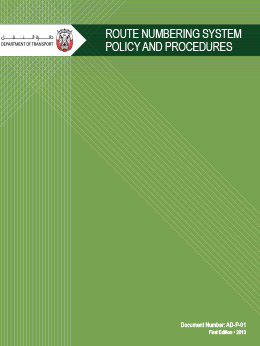 The Abu Dhabi Department of Transport (DoT) has produced the Route Numbering System (RNS) Policy and Procedure document to serve as the basis for instituting, marking, and labelling route numbering on the road system within the Emirate. It includes definition of the requirements for major Emirates or “E” routes serving inter-Emirate and international traffic (in concurrence with the UAE National Transport Authority, or NTA) as well as the requirements for a primary Abu Dhabi or “AD” route network serving cities, towns and communities along strategic roads within the Emirate. This network includes primary urban and rural routes, whether maintained by the DoT or by individual municipalities or other public or private entity. The intent of the RNS is to:
The Abu Dhabi Department of Transport (DoT) has produced the Route Numbering System (RNS) Policy and Procedure document to serve as the basis for instituting, marking, and labelling route numbering on the road system within the Emirate. It includes definition of the requirements for major Emirates or “E” routes serving inter-Emirate and international traffic (in concurrence with the UAE National Transport Authority, or NTA) as well as the requirements for a primary Abu Dhabi or “AD” route network serving cities, towns and communities along strategic roads within the Emirate. This network includes primary urban and rural routes, whether maintained by the DoT or by individual municipalities or other public or private entity. The intent of the RNS is to:
The policies and procedures defined in the document will assist the DoT in identifying and designating numbered routes in Abu Dhabi, such that it supports development of a logical route numbering scheme that aids in providing route guidance for drivers and in supporting the DoT and Municipalities in the development, operation and maintenance of the Emirate’s strategic road network. In addition, through outreach efforts involving the NTA, UAE Ministry of Public Works, and other Emirates’ transportation staffs, a standardized policy relative to the UAE’s national network of E-routes has been defined by DoT and provided to NTA for distribution and implementation throughout the UAE.
In addition, the Manual defines a hierarchy of international/national and inter-emirate roads (the E-routes), consistent with national practices, and intra-Emirate roads, the AD routes, that link these international/national and inter-emirate routes to local residential and business areas, destinations, and important transport, business and institutional centers.
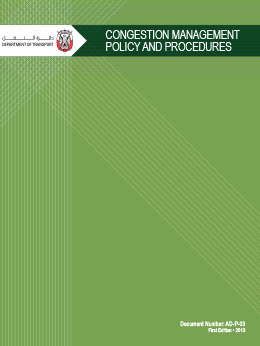 The Abu Dhabi Department of Transport (DoT) has developed and is implementing a Congestion Management Policy and Procedure (CMPP) as an integral part of ongoing transportation planning processes at the regional and local levels within the Emirate. The CMPP is a systematic planning process for measuring, reporting and managing roadway congestion in a specific region or corridor. The intent is to integrate the CMPP into Abu Dhabi’s existing planning activities and help with ultimately achieving the goals of the Surface Transport Master Plan.
The Abu Dhabi Department of Transport (DoT) has developed and is implementing a Congestion Management Policy and Procedure (CMPP) as an integral part of ongoing transportation planning processes at the regional and local levels within the Emirate. The CMPP is a systematic planning process for measuring, reporting and managing roadway congestion in a specific region or corridor. The intent is to integrate the CMPP into Abu Dhabi’s existing planning activities and help with ultimately achieving the goals of the Surface Transport Master Plan.
The CMPP shall provide the process for development of targeted Congestion Management Plans (CMP) that address particular regions and corridors within the Emirate. Each CMP evaluates and provides the mechanism for monitoring transportation performance and congestion on the multi-modal regional transportation system using established performance measures, and is managed through the development of a series of transportation improvement strategies. The CMPP intends to protect the Emirate's investments in, and improve the effectiveness of the existing and future transportation network by not allowing the system to reach unacceptable operating conditions.
The objectives of this document are thus summarized below:
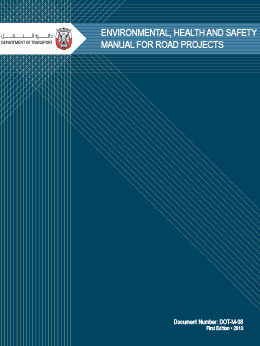 The Environmental, Health & Safety (EHS) Manual provides an overarching framework for managing EHS hazards and risks arising from construction, maintenance, and rehabilitation projects for the Abu Dhabi Department of Transport (DoT). The manual is consistent with the EHS Regulatory Framework promulgated by the Environment Agency Abu Dhabi (EAD) and the Abu Dhabi Environment, Health and Safety Centre (Abu Dhabi EHS Centre),the Municipality of Abu Dhabi City HSE Manual and the Abu Dhabi Municipalities and Agricultural Department Health and Safety Codes of Practice (CoPs) for Construction Projects.
The Environmental, Health & Safety (EHS) Manual provides an overarching framework for managing EHS hazards and risks arising from construction, maintenance, and rehabilitation projects for the Abu Dhabi Department of Transport (DoT). The manual is consistent with the EHS Regulatory Framework promulgated by the Environment Agency Abu Dhabi (EAD) and the Abu Dhabi Environment, Health and Safety Centre (Abu Dhabi EHS Centre),the Municipality of Abu Dhabi City HSE Manual and the Abu Dhabi Municipalities and Agricultural Department Health and Safety Codes of Practice (CoPs) for Construction Projects.
The primary purpose of this Manual is to provide the process map for DoT Main Roads personnel and contractors that clearly delineate the regulatory requirements and DoT expectations when engaging contractor services. This Manual aims to provide contractors with a framework and guidelines to identify and proactively manage potential environmental impacts and health and safety risks that have the potential to occur during road construction projects. This Manual provides guidance and topic-specific checklists and templates for a contractor to use and lead them through the conformance and compliance expectations when conducting Main Road project activities. This Manual includes an overview of each topic as addressed through the EHS CoPs, as well as an associated self-auditing checklist that addresses topics of concern, to help implement the requirements of each EHS CoP in simple terms (checklists are included in Appendix A of the Manual). Meeting and exceeding the EHS guidelines in this Manual will ensure that EHS requirements are communicated effectively to all categories of DoT personnel, including staff, contractors, consultants, visitors, and the public.
In addition, in an effort to improve consistency, eliminate redundancy, continually improve enterprise-wide requirements, and identify best practices, the government of Abu Dhabi recently engaged in a thorough review and revamping of government sector CoPs governing the regulatory elements of EHS compliance. Given the changing regulatory environment, it is imperative that this manual, as well as all associated guidance, undergo review regularly to ensure that the information and process map remain current. In addition, the standard list of Abu Dhabi CoPs should be consulted to ensure compliance, given they represent the primary governing regulations, yet remain somewhat in flux.
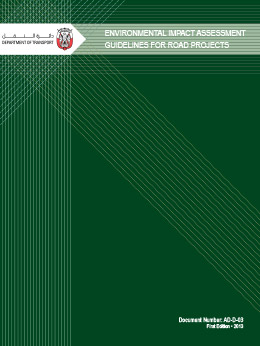 The Environmental Assessment Manual (Manual) covers requirements and guidelines that define the assessment of environmental resources during the planning, design, construction, and post-construction phases of a Main Roads Project. The Manual is intended to provide detailed information on the environmental process relative to the management, planning, design, construction and maintenance of Abu Dhabi Main Roads projects with consideration of the latest local, federal, and international laws, regulations, statutes, and policies. Additionally the Manual serves as a tool to aid DoT and other responsible authorities, contractors and other stakeholders in making sound environmental decisions, complying with regulatory procedures, and conforming to sustainability and environmental best management practices. To fulfill the intentions of the Manual, the structure of the Manual focuses on the Environmental Agency - Abu Dhabi (EAD) environmental permitting process and is intended to be used as a reference guide in association with the EAD Technical Guidance Documents for preparing a Preliminary Environmental Review (PER), Strategic Environmental Assessment (PEA), Environmental Impact Assessment (EIA), and / or a Terms of Reference (TOR) when required by EAD for a proposed project.
The Environmental Assessment Manual (Manual) covers requirements and guidelines that define the assessment of environmental resources during the planning, design, construction, and post-construction phases of a Main Roads Project. The Manual is intended to provide detailed information on the environmental process relative to the management, planning, design, construction and maintenance of Abu Dhabi Main Roads projects with consideration of the latest local, federal, and international laws, regulations, statutes, and policies. Additionally the Manual serves as a tool to aid DoT and other responsible authorities, contractors and other stakeholders in making sound environmental decisions, complying with regulatory procedures, and conforming to sustainability and environmental best management practices. To fulfill the intentions of the Manual, the structure of the Manual focuses on the Environmental Agency - Abu Dhabi (EAD) environmental permitting process and is intended to be used as a reference guide in association with the EAD Technical Guidance Documents for preparing a Preliminary Environmental Review (PER), Strategic Environmental Assessment (PEA), Environmental Impact Assessment (EIA), and / or a Terms of Reference (TOR) when required by EAD for a proposed project.
The Manual provides an overview of applicable laws and regulations that apply to the protection of Abu Dhabi’s environmental resources; a brief description of each of the physical, natural, and cultural resources of Abu Dhabi; and identifies the types of potential impacts that may occur to each resource and the mitigation measures and practices that, when employed, can avoid or minimize potential impacts.
The Manual is primarily intended to be used by Department of Transport (DoT) or other responsible authority professionals engaged in the environmental assessment process of Main Roads Projects. Professionals, agencies and stakeholders involved in a proposed project may also use the Manual.
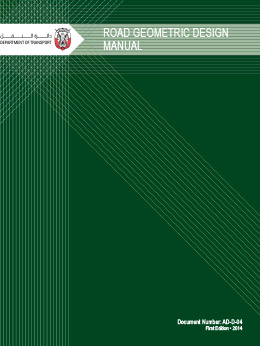 The Road Geometric Design Manual (RGDM) provides a clear understanding of the practices, standards, criteria, and procedures for the design of roads on the Emirate of Abu Dhabi’s road network. It fosters best practices in road design by incorporating up-to-date and innovative design techniques into the overall design and by providing consistent direction for road projects on the Emirate’s road network.
The Road Geometric Design Manual (RGDM) provides a clear understanding of the practices, standards, criteria, and procedures for the design of roads on the Emirate of Abu Dhabi’s road network. It fosters best practices in road design by incorporating up-to-date and innovative design techniques into the overall design and by providing consistent direction for road projects on the Emirate’s road network.
The basic purpose of the RGDM is:
The primary audience for the RGDM is the owner’s employees, other relevant authorities, consultants, and contractors for the design and construction of roads in the Abu Dhabi Emirate.
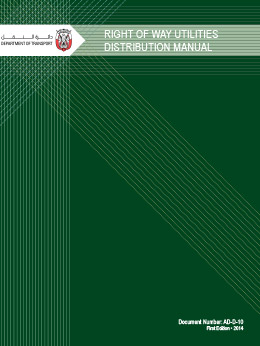
The purpose of this manual is to:
The compiled information is to be adopted while developing certain design details related to the distribution and placement of utilities. Whereas, the NOC related guidelines provide details regarding NOC procedures and requirements within the government authorities including Abu Dhabi Department of Transport (DoT), regulatory organizations and other Services Authorities and Utility Providers (SAUP).
The manual is developed in the interests of safety, protection, utilization, and future development of roads with due consideration given to adequate and economical utility installations. Furthermore, the prescribed design standards do not impair the road or its aesthetic quality, and also do not conflict with the provisions detailed in the UAE Laws or Regulations.
The scope of this manual is confined to the design details of the utilities that are located within Right of Way (ROW) corridors reserved along the Main roads that fall under the domain of DoT. However, in certain instances, components of public transport infrastructure such as bus stops, metro lines and/or railway lines can also become part of the Main roads and share the same ROW.
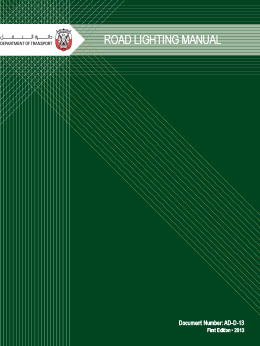
The Standard Drawings Manual is based on the best local and international practices keeping local requirements and conditions in view. The standards in this manual contain standard drawings for road civil works, bridges, surface drainage, lighting, street furniture, traffic, utilities, landscaping, etc. These drawing standards apply to the above mentioned roadway elements within the Emirate of Abu Dhabi.
The first step in the development process of Standard Drawings Manual would be thorough review of existing local and best international practices and the relevant literature. In this regard, the following steps were adopted:
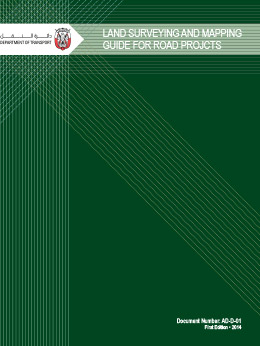
The Land Surveying and Mapping Guide for Road Projects (LSMG) provides a clear understanding of the practices, standards, criteria, and procedures for conducting survey work for road projects within the Emirate of Abu Dhabi. The basic purpose of the LSMG is to:
The manual introduces procedures to work with survey equipment now being used throughout the Emirate, in addition to, the latest surveying and mapping equipment identified through the review of best international practices. The manual will be a stand-alone and does not supplement any other manual. Major elements covered in this manual include Data Management, General Survey Requirements, Control Surveys, Design Surveys, Bridge Surveys, Digital Terrain Modelling Surveys, Land Surveys, Construction Surveys, Aerial Surveys, Mapping, etc.
The primary audience for the Guide is the owner’s employees; other relevant authorities; and owner’s agents such as consultant design engineers and surveyors, contractor execution engineers and surveyors, and survey consultants when conducting survey, design and execution of road projects within the Abu Dhabi Emirate.
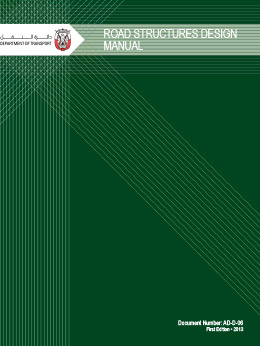 The Road Structures Design Manual (RSDM) will foster best practices in structural design by incorporating up-to-date and innovative design techniques into the overall design process and by providing flexibility for structural design projects on the Emirate’s main road network.
The Road Structures Design Manual (RSDM) will foster best practices in structural design by incorporating up-to-date and innovative design techniques into the overall design process and by providing flexibility for structural design projects on the Emirate’s main road network.
The basic purpose and scope for the Abu Dhabi Road Structures Design Manual (RSDM, the Manual) is as follows:
The Manual is based on the AASHTO LRFD Bridge Design Specifications, 6th Edition, 2012 (1) (BDS) and:
In addition, the Manual discusses, for selected applications, the intent of the BDS to assist the bridge designer in proper application.
The Manual will be revised periodically as newer editions of the BDS are published. If newer editions of the BDS (and any Interims) become available before the Manual is revised, then the more recent editions of the BDS shall govern.
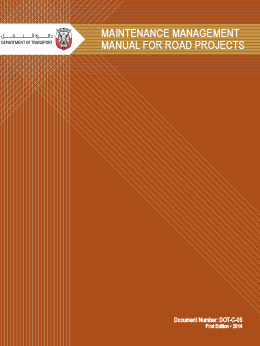 The Maintenance Management Manual for Road Projects (MMMRP) will foster best practices in the maintenance of road projects by incorporating up-to-date and innovative techniques into the overall process for maintenance of the Emirate’s main road network.
The Maintenance Management Manual for Road Projects (MMMRP) will foster best practices in the maintenance of road projects by incorporating up-to-date and innovative techniques into the overall process for maintenance of the Emirate’s main road network.
The Maintenance Management Manual for Road Projects (MMMRP) provides a clear understanding of the practices, standards, criteria, and procedures for maintaining roads and related structures on the Emirate of Abu Dhabi’s main road network. The basic purpose of the MMMRP is:
The primary audience for the MMMRP is the owner’s employees, other relevant authorities, consultants, and contractors for the maintenance of road structures in the Abu Dhabi Emirate.
The Manual has been prepared to provide guidelines to be used by transportation authorities’ staffs, consultants, and contractors supervising, overseeing, and performing maintenance work on the roads. Although, the Manual was specifically developed for application by the Department of Transport, the basic principles and policies discussed in the Manual are applicable to other road agencies in the Emirates.
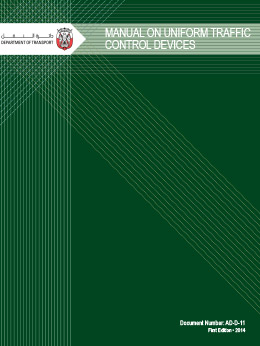 The MUTCD will provide the minimum requirements to assure that all road and street signing in the Emirate presents clear and concise regulatory, warning, and guidance information for both residents and visitors, and promotes and enhances travel safety. The targeted audiences of the devices presented in the manual are road and street users, whether they are vehicle operators, pedestrians, or cyclists using the facilities.
The MUTCD will provide the minimum requirements to assure that all road and street signing in the Emirate presents clear and concise regulatory, warning, and guidance information for both residents and visitors, and promotes and enhances travel safety. The targeted audiences of the devices presented in the manual are road and street users, whether they are vehicle operators, pedestrians, or cyclists using the facilities.
The Manual will be a basic reference for all Abu Dhabi Department of Transport (DoT) engineering staff as well as the staffs of all Municipalities within the Emirate. In addition, the document is to serve as a reference for all private road development activities in order to assure consistency of basic roadway information regardless of facility.
While there has been a good deal of work in developing traffic control manuals in the UAE (e.g., Abu Dhabi Municipality, Dubai RTA, GCC), the DoT MUTCD is not merely be a compilation of existing practices. Emerging operational strategies including electronic real-time sign displays, development of an Emirate-wide routing scheme, and international efforts to improve human factors characteristics of signs (text size, graphics, layout) all point to the need for “next generation” traffic control and guidance in the Emirate.
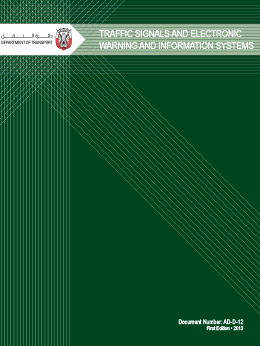 This Manual covers guidelines and standards that define the development of signal and electronic warning and information systems. The Manual covers elements of design, operations and maintenance that should be considered by managers and engineers when performing planning studies and/or developing design plans for signal and electronic warning and information systems. The Manual addresses local practices in Abu Dhabi, but also covers other standard applications that are used internationally which also have significant relevance to the operations of modernized signals in general. Target users of this Manual include, but are not limited to Executives and Decision Makers, Managers, Engineers and Designers, Technicians, Contractors, Equipment Vendors, and Academia.
This Manual covers guidelines and standards that define the development of signal and electronic warning and information systems. The Manual covers elements of design, operations and maintenance that should be considered by managers and engineers when performing planning studies and/or developing design plans for signal and electronic warning and information systems. The Manual addresses local practices in Abu Dhabi, but also covers other standard applications that are used internationally which also have significant relevance to the operations of modernized signals in general. Target users of this Manual include, but are not limited to Executives and Decision Makers, Managers, Engineers and Designers, Technicians, Contractors, Equipment Vendors, and Academia.
 The Road Lighting Manual (Manual) covers requirements and guidelines for the planning, design, and installation of road lighting within the Abu Dhabi Emirate. The Manual is intended to provide detailed information on the roadway lighting relative to the management, planning, design, construction and maintenance of Abu Dhabi Main Roads projects with consideration of the latest local, federal, and international laws, regulations, statutes, and policies. Additionally, the Manual serves as a tool to aid DoT and other responsible authorities, designers, contractors and stakeholders in making sound decisions, complying with regulatory procedures, and conforming to sustainability and best management practices.
The Road Lighting Manual (Manual) covers requirements and guidelines for the planning, design, and installation of road lighting within the Abu Dhabi Emirate. The Manual is intended to provide detailed information on the roadway lighting relative to the management, planning, design, construction and maintenance of Abu Dhabi Main Roads projects with consideration of the latest local, federal, and international laws, regulations, statutes, and policies. Additionally, the Manual serves as a tool to aid DoT and other responsible authorities, designers, contractors and stakeholders in making sound decisions, complying with regulatory procedures, and conforming to sustainability and best management practices.
The primary purpose of roadway lighting is to produce quick, accurate, safe and comfortable visibility at night or when visibility is low. These qualities of visibility may safeguard, facilitate, and encourage vehicular and pedestrian traffic. Every designer should provide for those inherent qualities required by the user. A very important consideration is that of making streets and roadways useful during hours of darkness as well as during the daytime. Where good visibility is provided through lighting, efficient night use can be made of the large investments in roadways and motor vehicles. Thus, the proper use of roadway lighting as an operative tool provides economic and social benefits to the public including:
This manual includes information on the purpose and impacts of roadway lighting levels, acceptable styles of lighting poles and fixtures, priority and associated aspects of roadway lighting such as designing with reducing light pollution in mind.
The manual provides appropriate illumination standards for different types of roadway facilities (e.g., high speed, low speed), land use characteristics (e.g., urban, rural), footpaths, cycle-ways, complex roadway geometry (e.g., interchanges), intersections, bridges, and underpass/tunnel lighting.
The intended target users for this manual are transportation planners, designers, construction contractors, and the agencies’ staff responsible for planning, design, operations and maintenance of Road Lighting facilities.
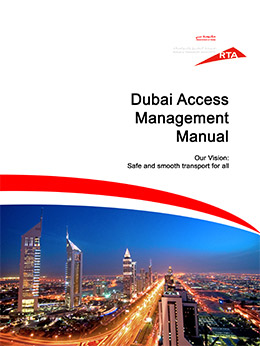 Access management is the application of roadway design and traffic operations considerations to the location and design of access from the highway to the adjacent land uses. The objective is to ensure roadway safety and operation efficiency while providing reasonable access to the adjacent land uses.
Access management is the application of roadway design and traffic operations considerations to the location and design of access from the highway to the adjacent land uses. The objective is to ensure roadway safety and operation efficiency while providing reasonable access to the adjacent land uses.
The Dubai Access Management Manual (AMM) provides clarification of the administrative procedures for implementing an access management program and standards. This includes policy, planning, design, and highway system operations. The manual also provides careful attention to access issues when land use and development decisions are made. In addition, the manual details the TIS requirements including road hierarchy, trip generation, trip distribution, parking supply and demand, transportation planning model runs, and existing and future conditions analysis, mitigation measures, analysis of mitigation measures and cost sharing calculations. Furthermore, the Dubai AMM provides Access management techniques based on established traffic engineering and roadway design principles.